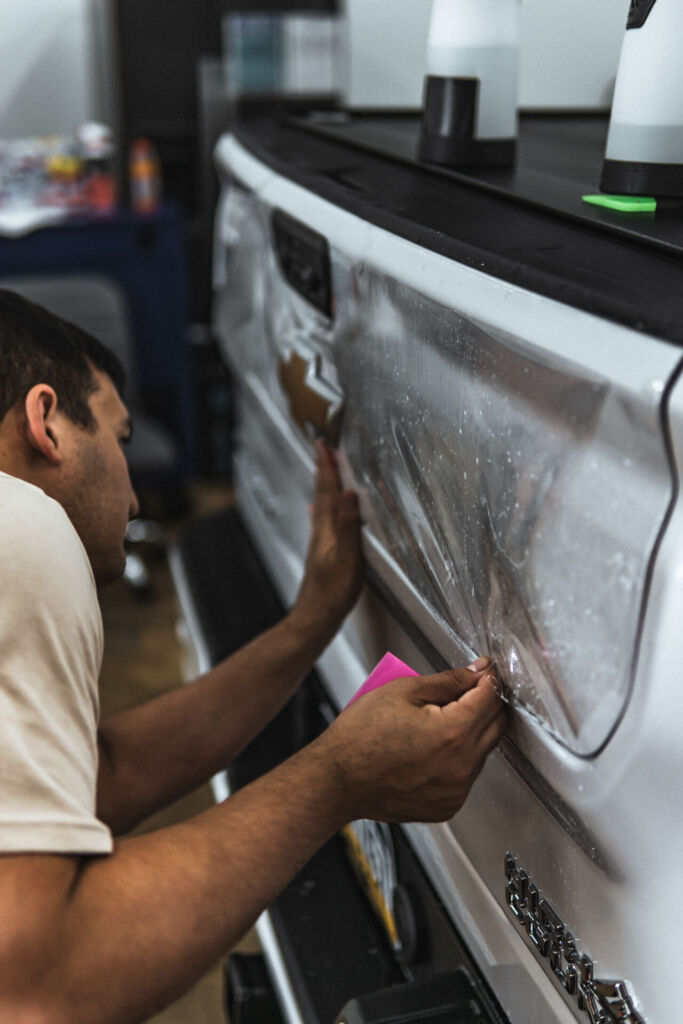When it comes to keeping your vehicle looking pristine, one of the most effective ways to protect its paint is by installing paint protection film (PPF). Whether you’re looking to preserve your car’s appearance or simply want to keep it in top condition, PPF can offer long-lasting protection. In this blog, we’ll walk you through what to expect when getting PPF installed on your vehicle, from preparation to aftercare.
Types of PPF on the market
There are several types of PPF available on the market, each offering unique features designed to meet different needs and preferences. Here are the most common types of PPF you can find today:
- Glossy PPF: This is the most popular type of PPF, designed to maintain the car’s original shine and gloss. It provides a clear, high-gloss finish that enhances the paint’s depth and vibrancy while offering durable protection from scratches, rock chips, and environmental contaminants.
- Matte PPF: For a more unique and sleek look, matte PPF offers a smooth, non-reflective finish. It provides the same protective benefits as glossy PPF but without the shine. This option is perfect for vehicles with matte or satin finishes, or those looking for a more customized, modern appearance.
- Self-Healing PPF: One of the most advanced types of PPF, self-healing films are designed to “heal” themselves over time. Minor scratches and swirl marks will disappear when exposed to heat (either from the sun or a heat gun), keeping your vehicle looking brand new for longer.

Preparing your vehicle for PPF installation
Before getting PPF installed on your vehicle, proper preparation is essential to ensure the film adheres smoothly and provides maximum protection. Here’s what you can expect during the preparation phase:
- Vehicle inspection: The first step is an inspection to check for any existing damage or imperfections in the paint, such as chips, scratches, or swirl marks.
- Cleaning and decontamination: The vehicle will undergo a thorough cleaning to remove dirt, grime, and debris. This step is crucial because any contaminants left on the surface can affect the adhesion of the film.
- Paint correction (if needed): If there are visible paint imperfections, a technician may perform a paint correction to improve the overall look of the vehicle before applying the PPF.
- Drying: Once the car is cleaned and prepared, it will be thoroughly dried to remove any moisture that could interfere with the PPF application.
The PPF installation process
Here’s a basic overview of what happens during the installation:
- Film application: The PPF is carefully applied to the vehicle’s surface. It may be pre-cut to fit your vehicle or customized on-site for a more precise fit.
- Heat and stretching: The film is heated and stretched to conform to the car’s surface. This ensures that the PPF adheres seamlessly and covers every curve and edge without wrinkles or bubbles.
- Edge trimming and sealing: Once the film is applied, the edges are trimmed to ensure a clean, finished look. The technician will also seal the edges to prevent peeling or lifting over time.
- Curing time: After installation, the PPF needs time to cure and bond with the paint. It typically takes 24-48 hours for the film to fully adhere.

Aftercare and maintenance
Once your PPF has been installed, proper aftercare and maintenance are essential to ensure that it performs at its best and lasts for years.
- Regular cleaning: After the initial curing period, regular cleaning is recommended to keep your PPF looking great. You can wash the vehicle as you would normally, but avoid using abrasive sponges or harsh chemicals that could damage the film. Using gentle car wash soap and microfiber cloths will help keep the film in excellent condition.
- Avoid high-pressure washes: While the PPF is durable, high-pressure washers can be too harsh and may cause the film to peel at the edges. It’s best to wash your vehicle with a gentle stream of water or a hand wash to avoid any unnecessary damage.
- Inspection and touch-ups: Over time, the PPF may show signs of wear and tear, especially if exposed to harsh road conditions. It’s important to inspect the film periodically for any bubbling, peeling, or lifting. If you notice any issues, professional touch-ups or repairs can be done to restore the film’s integrity.
Learn more instructions on how to protect your car’s PPF all year round:
- Protect Your Car’s Paint With PPF Before Summer Arrives
- Why You Should Consider PPF Before Spring Road Trips
How can I get professional PPF installed on my vehicle near me in Hagerstown, MD?
If you’re looking to get professional PPF installed on your vehicle near Hagerstown, MD, choose Inspire Detailing LLC. Inspire Detailing offers expert PPF installation to protect your vehicle’s paint from scratches, chips, and environmental damage. With our skilled technicians and advanced materials, you can trust that your car will receive high-quality protection.
Call us at 240-850-0160 to schedule your appointment today! Or visit us at 415 S. Conococheague St, Suite #400, Williamsport, MD 21795

